Hemiramphidae is a family of fishes that are commonly called halfbeaks, spipe fish or spipefish. They are a geographically widespread and numerically abundant family of epipelagic fish inhabiting warm waters around the world. The halfbeaks are named for their distinctive jaws, in which the lower jaws are significantly longer than the upper jaws. The similar viviparous halfbeaks have often been included in this family.
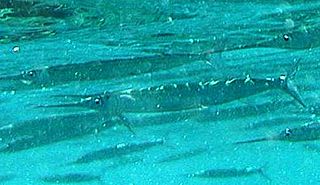
Hemiramphus is a genus of schooling marine fish commonly called halfbeaks, garfish, or ballyhoos, and are members of the family Hemiramphidae. They inhabit the surface of warm temperate and tropical sea, and feed on algae, plankton, and smaller fish. Hemiramphus species are edible but are more important as food fish for larger predatory species including dolphinfish and billfish.

The yellowtail barracuda is one of the smaller species of barracuda of the family Sphyraenidae, which can be found in Indo-West Pacific oceans. It has also invaded the Mediterranean through the Suez Canal from the Red Sea, making it one of the Lessepsian migrants.

The yellow-edged lyretail also known as the yellowedge coronation trout, fairy cod, lunar tail rock cod, lunartailed cod, lyre-tail cod or moontail seabass,, is a species of marine ray-finned fish, a grouper from the subfamily Epinephelinae which is part of the family Serranidae, which also includes the anthias and sea basses. It is found in the Indo-Pacific region and is more common than the congeneric white-edged lyretail.

The shrimp scad, is a species of widespread tropical marine fish of the jack family, Carangidae. The shrimp scad is widely distributed in the tropical and subtropical western Indian Ocean and areas of the eastern Pacific Ocean, ranging from South Africa in the west to Hawaii in the east, including Japan and Australia to the north and south. The species is commonly found on inshore reefs and sandy substrates. It has the common body profile of a scad, and may be difficult to differentiate from others in the genus Alepes. It is one of the larger scads, growing to 40 cm, but often is encountered at much smaller sizes. The shrimp scad often forms large schools, and is carnivorous, consuming a variety of crustaceans and small fish. It is of moderate importance to fisheries throughout its range.

The northern whiting, also known as the silver whiting and sand smelt, is a marine fish, the most widespread and abundant member of the smelt-whiting family Sillaginidae. The northern whiting was the first species of sillaginid scientifically described and is therefore the type species of both the family Sillaginidae and the genus Sillago. The species is distributed in the Indo-Pacific region from South Africa in the west to Japan and Indonesia in the east. The northern whiting inhabits coastal areas to 60 m, but is most often found in shallow water around bays and estuaries, often entering freshwater. It is a carnivore, taking a variety of polychaetes and crustaceans. The species is of major economic importance throughout the Indo-Pacific. It is most frequently taken by seine nets and cast nets and marketed fresh.
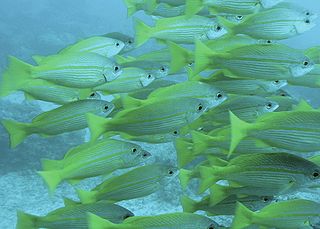
Lutjanus is a genus of marine ray-finned fish, snappers belonging to the family Lutjanidae. They are found in the Atlantic, Indian, and Pacific Oceans. They are predatory fish usually found in tropical and subtropical reefs, and mangrove forests. This genus also includes two species that only occur in fresh and brackish waters.
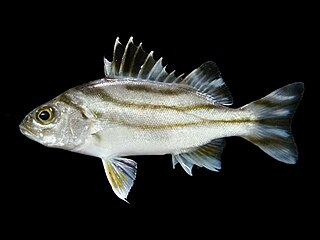
Terapon jarbua, the jarbua terapon, crescent grunter, crescent banded grunter, crescent perch, spiky trumpeter, thornfish or tiger perch, is a species of ray-finned fish, a grunter of the family Terapontidae. It occurs in the Indo-Pacific. it is an important commercial species within its range and is sometimes found in the aquarium trade where it is known as "target fish" for the pattern visible from above.
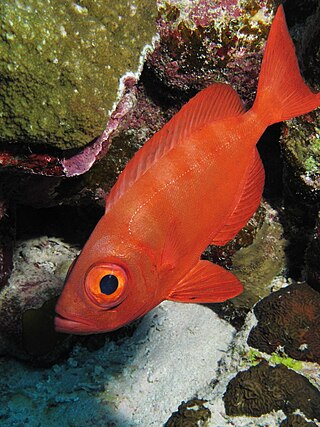
Priacanthus hamrur, the lunar-tailed bigeye, goggle eye, or moontail bullseye, is a species of marine fishes belonging to the family Priacanthidae.
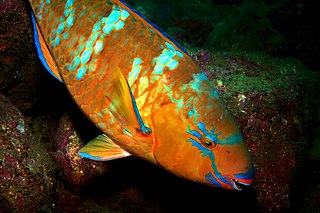
Scarus ghobban, also known as the blue-barred parrotfish, blue trim parrotfish, cream parrotfish, globe-headed parrotfish, green blotched parrotfish, yellow scale parrotfish, and bluechin parrotfish, is a species of marine ray-finned fish in the family Scaridae.

Lutjanus fulviflamma, the dory snapper, blackspot snapper, black-spot sea perch, finger-mark bream, long-spot snapper, Moses perch or red bream, is a species of marine ray-finned fish belonging to the family Lutjanidae, the snappers. It has a wide Indo-Pacific distribution.

Ostorhinchus fasciatus, commonly known as the broad-banded cardinalfish, is a marine fish native to the Indian and Pacific Oceans which is a Lessepsian migrant to the eastern Mediterranean through the Suez Canal from the Red Sea, it was first recorded off Israel in 2008 and has now reached the southern coast of Turkey. It has a number of vernacular names including barred striped cardinalfish, four-banded soldier-fish, striped cardinalfish and twostripe cardinalfish.

Terapon puta, the spiny-checked grunter, three-lined grunter, small-scaled banded grunter, small-scaled terapon, squeaking perch or two-lined grunter, is a species of fish from the Indo-Pacific region, it is a member of the grunter family, Terapontidae. It has also spread into the eastern Mediterranean Sea from the Red Sea through the Suez Canal, a process known as Lessepsian migration.

Crenidens crenidens, the karanteen seabream or karanteen, is a species of ray-finned fish from the sea bream family Sparidae which was described by the Swedish zoologist Peter Forsskål in 1775. It is native to the western Indian Ocean but has colonised the eastern Mediterranean Sea since 1970. It is one of only three species in genus Crenidens, the others being the little known Crenidens macracanthus and the partially sympatric C. indicus.
Hyporhamphus affinis, the tropical halfbeak, tropical garfish, insular halfbeak or coral reef halfbeak, is a species of schooling marine fish from the family Hemiramphidae. It is distributed through the Indo-Pacific regions and has been recorded in the Mediterranean Sea which it reached through the Suez Canal.

Siganus rivulatus, the marbled spinefoot, rivulated rabbitfish or surf parrotfish, is a gregarious, largely herbivorous ray-finned fish of the family Siganidae. Its natural range encompasses the western Indian Ocean and the Red Sea from where it colonised the Mediterranean Sea by Lessepsian migration through the Suez Canal. It is the type species of the genus Siganus.

Ashtoret lunaris, also known as the yellow moon crab, spotted moon crab or box crab, is an Indo-Pacific species of carnivorous crab which is a member of the family Matutidae. It has been recorded in the eastern Mediterranean since 2010, likely reaching it via the Suez Canal from the Red Sea by.
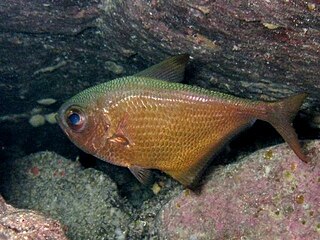
Pempheris mangula, the black-edged sweeper, Moluccan sweeper or black-margin bullseye is a species of Indo-Pacific sweeper from the family Pempheridae. The history of the identification of the Indo-Pacific sweepers is complex and this species has been identified as the "Pempheris vanicolensis" which has colonised the Mediterranean Sea from the Red Sea via the Suez Canal by Lessepsian migration but this identification is not universally accepted.
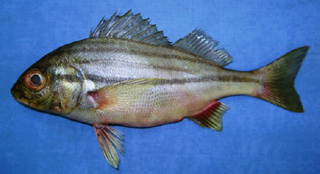
Pomadasys stridens, the striped piggy or lined piggy, is a grunt from the western Indian Ocean, it is one of a group of Indo-Pacific marine species which have colonised the Mediterranean Sea through the Suez Canal from the Red Sea, a process known as Lessepsian migration.
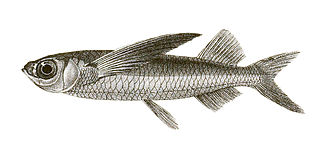
Parexocoetus mento; also known as the African sailfin flying fish, Cuvier's flying fish, the yellow belly flying fish or the short-winged flying fish; is a species of flying fish from the family Exocoetidae which is found in the Indo-pacific region and which has colonised the eastern Mediterranean.




















